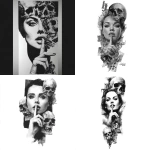Explore the Best AI Image Gallery

Imagining the Future: AI-Generated Images in Marketing
The marketing landscape is undergoing a rapid transformation, driven by advancements in artificial intelligence (AI). One of the most impactful developments is the emergence of AI-generated images, capable of producing stunning visuals with remarkable speed and efficiency. This technology is poised to revolutionize how brands create and share content, opening up new avenues for creativity and engagement.
From eye-catching social media posts to captivating website banners, AI-generated images offer a versatile toolkit for marketers. But this powerful technology also raises important ethical considerations that require careful consideration.
The Creative Canvas: Unleashing the Potential of AI
AI image generators leverage sophisticated algorithms trained on massive datasets of images and text. By understanding patterns and relationships within these datasets, they can generate original visuals tailored to specific prompts or requirements. This opens up a world of possibilities for marketers:
- Personalized Content: AI can create unique images that resonate with individual customer segments, enhancing engagement and conversion rates.
- Cost-Effective Production: Replacing the need for professional photographers or designers in many cases, AI-generated images can significantly reduce marketing costs.
- Rapid Content Creation: Generating high-quality visuals on demand allows marketers to respond quickly to trends and create timely content.
- Experimentation and Innovation: AI encourages experimentation with new visual styles and concepts, pushing the boundaries of creative expression.
Navigating the Ethical Landscape
While AI-generated images offer immense potential, their use in marketing also raises ethical concerns that must be addressed:
- Copyright and Ownership: Questions arise regarding the ownership of AI-generated content, particularly when trained on copyrighted material.
- Bias and Representation: AI algorithms can perpetuate existing societal biases, leading to potentially harmful or stereotypical representations in generated images.
- Transparency and Disclosure: It is crucial for marketers to be transparent about the use of AI-generated images and avoid misleading consumers.
- Job Displacement: The automation potential of AI raises concerns about job losses in creative industries.
Shaping the Future: Responsible Innovation
As AI-generated images become increasingly prevalent in marketing, it is essential to foster responsible innovation. This involves:
- Developing Ethical Guidelines:** Industry organizations and policymakers should establish clear guidelines for the ethical use of AI in content creation.
- Promoting Diversity and Inclusion: Ensuring that AI training datasets represent diverse perspectives and cultures to mitigate bias in generated images.
- Encouraging Transparency and Disclosure: Marketers should clearly label AI-generated content and provide information about its creation process.
- Investing in Education and Reskilling: Supporting the creative workforce through education and training programs to adapt to the evolving landscape.
AI-generated images have the power to revolutionize marketing, offering unprecedented creative possibilities. By embracing responsible innovation and addressing ethical considerations, we can harness the potential of this technology while safeguarding the integrity of the creative industry.
Conclusion
The future of marketing lies in a harmonious blend of human creativity and AI-powered innovation. As AI-generated images continue to evolve, marketers must remain adaptable, embracing new technologies while upholding ethical standards. By navigating this landscape responsibly, we can unlock a world of creative possibilities and shape a more inclusive and innovative marketing ecosystem.




](https://images.ai-img.art/thumbnails/150/b90a5f332cb5d8f02116934e13abd20233e0eeb2368274dbdffaa2e281e4dff5.webp)






](https://images.ai-img.art/thumbnails/150/4a4f2a16da94ebadad64aeb3b0fb4e64d426431f1d651cc4929142c728fe85b7.webp)




](https://images.ai-img.art/thumbnails/150/336026613fd234b8d6908fe18ecc09b2b2ecf7b8dfe294742041c9862dc499c1.webp)

](https://images.ai-img.art/thumbnails/150/d29fcfc8037938184a641f7980e1102e24a6e82088bc465886d26ffe5bb006c7.webp)












](https://images.ai-img.art/thumbnails/150/24610c8978ce6b4f1ced8639b434482871adb07e38af8b90cd535f2533bf18cc.webp)




](https://images.ai-img.art/thumbnails/150/37f115f2fa75765b87e6d3e2c9f1b0a80a6a46efa8b864a05278c7fc0a0a62e7.webp)
](https://images.ai-img.art/thumbnails/150/85464d88f1d4314cd042a02a6f41440fc3b4343db529794cbe8e6836fdadf409.webp)










](https://images.ai-img.art/thumbnails/150/9127f72c6be19d533c26ac476f4d216cd89a6a2d7c351333489a3eff30c3ec5a.webp)
